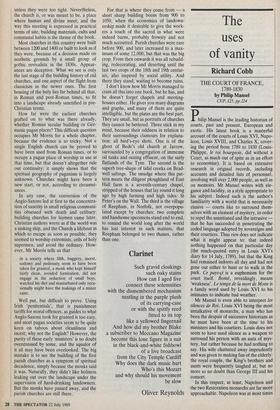The uses of vanity
Richard Cobb
THE COURT OF FRANCE, 1789-1830 by Philip Mansel
CUP, £25, pp.224
Philip Mansel is the leading historian of courts, past and present, European and exotic. His latest book is a masterful account of the courts of Louis XVI, Napo- leon, Louis XVIII, and Charles X, cover- ing the period from 1789 to 1830 (Louis- Philippe, le roi bourgeois, did without a Court, as much out of spite as in an effort to economise). It is based on extensive research in original records, including accounts and detailed lists of personnel, involving well over 2,000 people, as well as on memoirs. Mr Mansel writes with ele- gance and lucidity, in a style appropriate to his subject. Indeed such is the author's familiarity with a world that is necessarily elusive — courts like to surround them- selves with an element of mystery, in order to repel the uninitiated and the intrusive that he has succeeded in penetrating the coded language adopted by sovereigns and their courtiers. Thus rien does not indicate what it might appear to: that indeed nothing happened on that particular day (the much-quoted entry in Louis XVI's diary for 14 July, 1789), but that the King had remained indoors all day and had not gone out either to hunt or to walk in the park. Ce pays-ci is a euphemism for the court itself. Bonte, revealingly, means `weakness'. Le temps de la mort de Motte is a family word used by Louis XVI to his intimates to indicate bad weather.
Mr Mansel is even able to interpret les silences de Roi, Louis XVI being the most untalkative of monarchs, a man who has been the despair of successive historians as he must have been at the time to his ministers and his courtiers. Louis does not seem to have used silence as a weapon to surround his person with an aura of mys- tery, but rather because he had nothing to say. His wife chattered away imprudently and was given to making fun of the elderly: the royal couple, the King's brothers and aunts were frequently laughed at, but no more so no doubt than George III and his consort.
In this respect, at least, Napoleon and the two Restoration monarchs are far more approachable. Napoleon was at most times abominably rude to anyone, male or female, attending his court appearances. Louis XVIII could be polite when it suited him, though when he said will see' what he really meant was 'no'. Charles X was charming, affable and kind. Only a histo- rian as experienced in every nuance of court language and usage as Philip Mansel could have spotted the fact that when Louis XVII wrote to his uncle from the Temple, late in 1794, he signed himself `Louis' rather than 'Louis Charles': an affirmation that he was in fact the reigning king.
The author refers to Louis XVI's 'failure to use vanity as a weapon'; and on a number of occasions he insists that all courts represent vanity in its most institu- tionalised and effective form, commenting: `unlike his elder brother, Louis XVIII knew the importance of vanity'. It was because they were not accorded their full importance as Princes of the Blood that the dreadful Duke of Orleans and his son, the Duc de Chartres, the future Louis- Philippe, 'turned to liberalism out of jealousy'.
Such was the importance of the court that it was maintained, at full strength, right up to 10 August, 1792, though, after the October Days of 1789, it was domin- ated by fear, constant breaches of privacy and the recurring threat of violence — Mr Mansel has the wonderful phrase, 'a new world of yelling mobs, splintering doors and blood'. Napoleon's court was entirely military, on lines similar to those adopted by Berlin and St Petersburg. Louis XVIII used his court as a very effective agent of reconciliation; and Charles X was very much aware of the binding power of routine: 'it was not easy to surprise the King'. However, towards the end of his reign, as he had done in July 1789, he turned once more to the fatal Polignac brothers, who were anything but agents of reconciliation. The July Days would soon follow.
The author is completely at home with all the subtle nuances and the unstated assumptions of court life and he is very much aware of the importance of the household guard as a source of physical protection, especially after the horrors of the revolutionary period. Louis XVIII maintained his court in the very centre of Paris, in dangerous proximity to the river and two strategic bridges: but he made sure that his palace would not be invaded. The Royal Guards were not just uniformed courtiers; they discharged an essential Physical function which could, in a crisis, have been much more than merely ceremo- nial. In many other ways, also, there was a remarkable continuity, especially in terms of personnel, between the three courts that are studied with such brilliance in this remarkable book, itself a very effective antidote to the hot fevers of bicentenary- It's, festivals and dancing in the streets. The historian of Louis XVIII once more reminds us of the profound good sense of that admirable monarch. Perhaps now he will turn to the courts of the Spanish Bourbons, the Habsburgs and the Roma- noffs. This reviewer, at least, hopes so, for one could not be in better hands.



















































 Previous page
Previous page